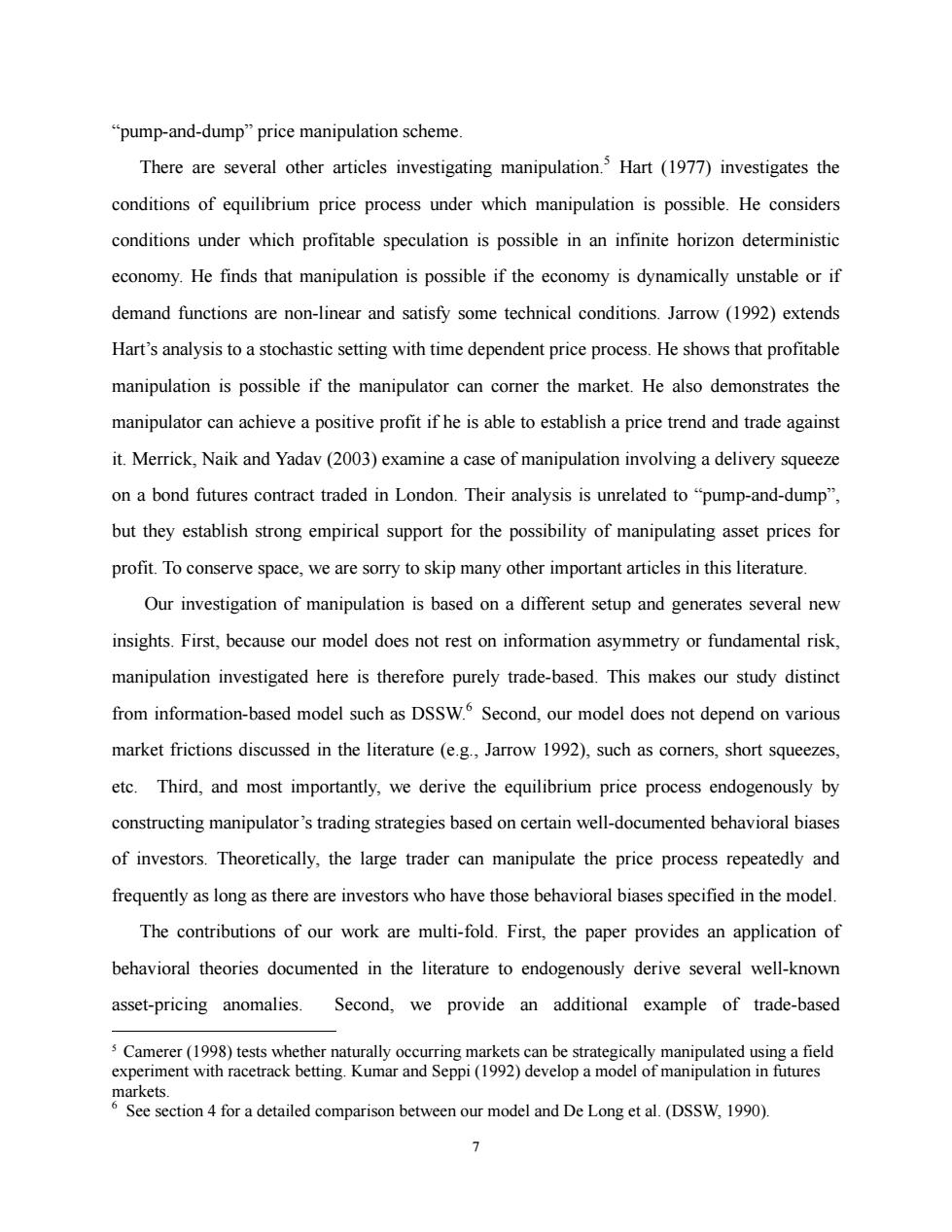正在加载图片...

"pump-and-dump"price manipulation scheme. There are several other articles investigating manipulation.3 Hart (1977)investigates the conditions of equilibrium price process under which manipulation is possible.He considers conditions under which profitable speculation is possible in an infinite horizon deterministic economy.He finds that manipulation is possible if the economy is dynamically unstable or if demand functions are non-linear and satisfy some technical conditions.Jarrow (1992)extends Hart's analysis to a stochastic setting with time dependent price process.He shows that profitable manipulation is possible if the manipulator can corner the market.He also demonstrates the manipulator can achieve a positive profit if he is able to establish a price trend and trade against it.Merrick,Naik and Yadav(2003)examine a case of manipulation involving a delivery squeeze on a bond futures contract traded in London.Their analysis is unrelated to "pump-and-dump", but they establish strong empirical support for the possibility of manipulating asset prices for profit.To conserve space,we are sorry to skip many other important articles in this literature. Our investigation of manipulation is based on a different setup and generates several new insights.First,because our model does not rest on information asymmetry or fundamental risk, manipulation investigated here is therefore purely trade-based.This makes our study distinct from information-based model such as DSSW.Second,our model does not depend on various market frictions discussed in the literature (e.g.,Jarrow 1992),such as corners,short squeezes, etc.Third,and most importantly,we derive the equilibrium price process endogenously by constructing manipulator's trading strategies based on certain well-documented behavioral biases of investors.Theoretically,the large trader can manipulate the price process repeatedly and frequently as long as there are investors who have those behavioral biases specified in the model. The contributions of our work are multi-fold.First,the paper provides an application of behavioral theories documented in the literature to endogenously derive several well-known asset-pricing anomalies.Second,we provide an additional example of trade-based 5 Camerer(1998)tests whether naturally occurring markets can be strategically manipulated using a field experiment with racetrack betting.Kumar and Seppi(1992)develop a model of manipulation in futures markets. 6 See section 4 for a detailed comparison between our model and De Long et al.(DSSW,1990). >7 “pump-and-dump” price manipulation scheme. There are several other articles investigating manipulation.5 Hart (1977) investigates the conditions of equilibrium price process under which manipulation is possible. He considers conditions under which profitable speculation is possible in an infinite horizon deterministic economy. He finds that manipulation is possible if the economy is dynamically unstable or if demand functions are non-linear and satisfy some technical conditions. Jarrow (1992) extends Hart’s analysis to a stochastic setting with time dependent price process. He shows that profitable manipulation is possible if the manipulator can corner the market. He also demonstrates the manipulator can achieve a positive profit if he is able to establish a price trend and trade against it. Merrick, Naik and Yadav (2003) examine a case of manipulation involving a delivery squeeze on a bond futures contract traded in London. Their analysis is unrelated to “pump-and-dump”, but they establish strong empirical support for the possibility of manipulating asset prices for profit. To conserve space, we are sorry to skip many other important articles in this literature. Our investigation of manipulation is based on a different setup and generates several new insights. First, because our model does not rest on information asymmetry or fundamental risk, manipulation investigated here is therefore purely trade-based. This makes our study distinct from information-based model such as DSSW.6 Second, our model does not depend on various market frictions discussed in the literature (e.g., Jarrow 1992), such as corners, short squeezes, etc. Third, and most importantly, we derive the equilibrium price process endogenously by constructing manipulator’s trading strategies based on certain well-documented behavioral biases of investors. Theoretically, the large trader can manipulate the price process repeatedly and frequently as long as there are investors who have those behavioral biases specified in the model. The contributions of our work are multi-fold. First, the paper provides an application of behavioral theories documented in the literature to endogenously derive several well-known asset-pricing anomalies. Second, we provide an additional example of trade-based 5 Camerer (1998) tests whether naturally occurring markets can be strategically manipulated using a field experiment with racetrack betting. Kumar and Seppi (1992) develop a model of manipulation in futures markets. 6 See section 4 for a detailed comparison between our model and De Long et al. (DSSW, 1990)